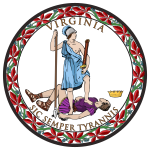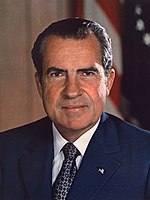| ||||||||||||||||||||||||||
| ||||||||||||||||||||||||||
 County and Independent City Results
| ||||||||||||||||||||||||||
| ||||||||||||||||||||||||||
| Elections in Virginia |
|---|
 |
The 1972 United States presidential election in Virginia took place on November 7, 1972. All 50 states and the District of Columbia were part of the 1972 United States presidential election. Virginia voters chose 12 electors to the Electoral College, which selected the president and vice president of the United States. This was also the first presidential election after the passage of the Twenty-sixth Amendment, which decreased the voting age from 21 to 18.
For over sixty years Virginia had had the most restricted electorate in the United States due to a cumulative poll tax and literacy tests.[1] Virginia would be almost entirely controlled by the conservative Democratic Byrd Organization for four of those decades,[2] although during the Organization’s last twenty years of controlling the state it would direct many Virginia voters away from the national Democratic Party due to opposition to black civil rights and to the fiscal liberalism of the New Deal.[3] After the Twenty-Fourth Amendment and Harper v. Virginia State Board of Elections the state’s electorate would substantially expand as the burden of poll taxes on the lower classes was removed. Contemporaneously the postwar Republican trend of the Northeast-aligned Washington D.C. suburbs, which had begun as early as 1944, would accelerate[4] and become intensified by the mobilisation of working-class Piedmont whites against a national Democratic Party strongly associated with black interests.[5]
After 1966 the statewide Democratic party was severely divided into conservative, moderate and liberal factions,[6] so that in addition to voting Republican in four of five presidential elections, Virginia’s Congressional delegation would gain a Republican majority as early as the 91st Congress, and Linwood Holton would become the first Republican governor since the 1880s Readjuster fusion. However, it was 1970 before significant GOP gains occurred in the state legislature, and it was generally acknowledged that President Nixon offered no support to down-ballot Republican candidates.[7] As of 2020, this remains the strongest ever Republican presidential performance in Virginia.
Cite error: There are <ref group=lower-alpha> tags or {{efn}} templates on this page, but the references will not show without a {{reflist|group=lower-alpha}} template or {{notelist}} template (see the help page).
- ^ Kousser, J. Morgan. The Shaping of Southern Politics Suffrage Restriction and the Establishment of the One-Party South, 1880-1910. Yale University Press. pp. 178–181. ISBN 0-300-01696-4.
- ^ Key, Valdimer Orlando (1949). Southern Politics in State and Nation. pp. 20–25.
- ^ Ely, James W. The crisis of conservative Virginia: the Byrd organization and the politics of massive resistance. p. 16. ISBN 0870491881.
- ^ Atkinson, Frank B. (2006). The Dynamic Dominion: Realignment and the Rise of Two-party Competition in Virginia, 1945-1980. Rowman & Littlefield. ISBN 9780742552098.
- ^ Phillips, Kevin P. (1969). The Emerging Republican Majority. pp. 260–266. ISBN 0870000586.
- ^ Bass, Jack; De Vries, Walter (1995). The Transformation of Southern Politics: Social Change and Political Consequence Since 1945. pp. 347–353.
- ^ Evans, Rowland; Novak, Robert (October 16, 1972). "Consider Virginia: McGovern, Nixon Creating a No-Party System in South". The Miami Herald. pp. 7-A.
© MMXXIII Rich X Search. We shall prevail. All rights reserved. Rich X Search


